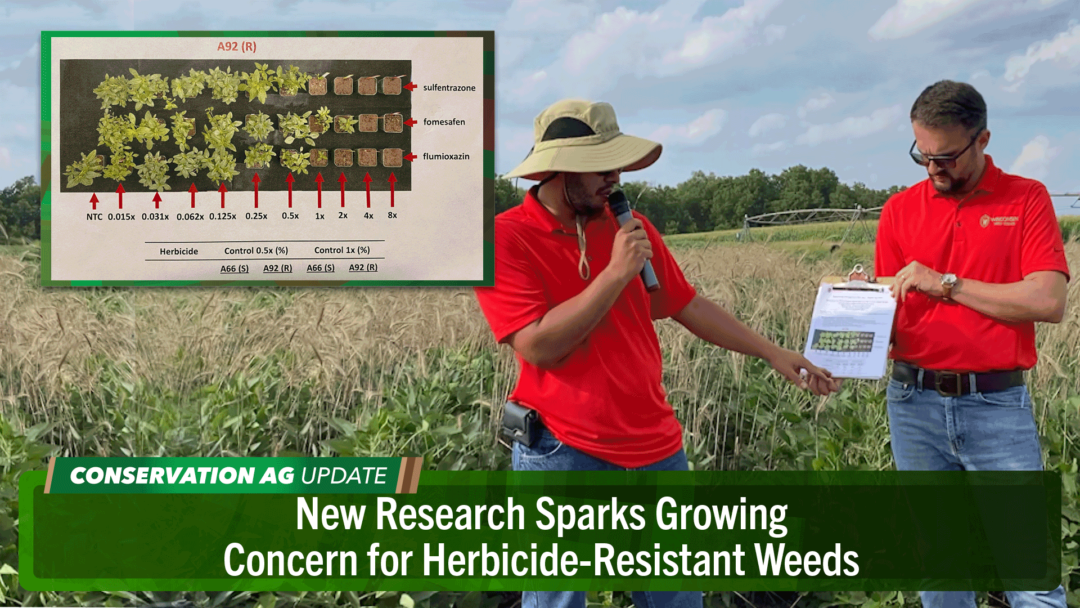On this episode of Conservation Ag Update, the University of Wisconsin Weed Science team shares results from a new study on herbicide-resistant waterhemp.
In the Cover Crop Connection segment, assistant editor Mackane Vogel stops by the Michael Fields Agricultural Institute field day to learn about alternative cover crops.
Plus, Eric Reed shares some of the secrets to his high-yielding success in less-than-ideal conditions on the Alabama/Tennessee border, we get the scoop on a dual-purpose perennial crop that’s showing major promise in the U.S., and say farewell to the John Deere Moldboard Plow 3710!
This episode of Conservation Ag Update is brought to you by Yokohama Off-Highway Tires.
VF tires are constructed with sidewalls that enable them to bear heavier loads and operate at lower inflation pressures than traditional radial tires. In fact, VF tires, like our Alliance AgriFlex+ range, can carry up to 40% more load than a conventional radial tire at the same inflation pressure or operate at up to 40% lower air pressure under the same load. VF tires offer quantifiable improvements on the farm. For example, the ability to carry heavier loads can cut down significantly on fuel use and reduce machine hours, while the ability to operate at lower inflation pressures allows tires to produce larger footprints, which can improve traction and reduce soil compaction. The best part is, you can choose which benefit works best for your operation. Learn More at https://yokohama-oht.com.
TRANSCRIPT
Jump to a section or scroll for the full episode...
- Study: Dousing Waterhemp with 2x Label Rate Still Doesn’t Kill It
- No-Till, Cross Slot Champion Keith Saxton Dies at 85
- Cultivating David Brandt’s Vision for Learning Center
- Examining the Properties of Buckwheat as an Alternative Cover Crop
- Farmer Feature: Eric Reed, Elora, Tenn.
- Kernza Shows Promise as Dual-Purpose Perennial Crop
- Video of the Week: Fare-Thee-Well John Deere Moldboard Plow 3710
Study: Dousing Waterhemp with 2x Label Rate Still Doesn’t Kill It
A dual-purpose perennial crop is showing major promise in the U.S. We’ll have that story coming up in just a bit, but we begin with new research on herbicide-resistant weeds.
The University of Wisconsin Cropping Systems Weed Science team hosted a waterhemp management field day in Brooklyn, Wis., highlighting some of its studies in 2023.
One project in particular sparks some concern over a growing population of herbicide-resistant waterhemp in Dodge County, Wis. Graduate student Felipe Faleco completed a greenhouse experiment that showed waterhemp still emerged even after being sprayed at two-times the recommended rate of different pre and post emergent herbicides like Flexstar and Valor EZ. Wisconsin weed scientist Rodrigo Werle puts it in perspective.
“The PPO herbicides are our foundation for residual control. What Felipe is documenting here in PPO resistant waterhemp — the residual herbicides are not lasting as long as they should have. Having a waterhemp emerge trough 8 ounces of Spartan, to me that’s scary. Because herbicides are meant to give us 6-7 weeks of residual control. And you’re not getting that right off the bat, that’s really concerning.”
More coverage from the event and details on those studies coming soon to No-TillFarmer.com
No-Till, Cross Slot Champion Keith Saxton Dies at 85
Sad news to report, Keith Saxton, a champion for no-till and the Cross Slot no-till opener design, has passed away at the age of 85 after battling health issues over the last few years. v
He became the first person to bring the Cross Slot technology into the U.S. in 1986. Cross Slot leaves residue directly over the seeded rows with almost no in-row soil disturbance. Saxton conducted much of the research into adopting the technology for extremely dry conditions faced by no-tillers in the northwestern U.S. and the prairie provinces of western Canada.
Cultivating David Brandt’s Vision for Learning Center
Before his death, no-till pioneer David Brandt was working to launch a farmer-led learning center. An effort is now underway to bring his vision to life.
A group of no-tillers are hosting an event at the Sinsinawa Mound Center in southern Wisconsin on September 14. Jay Brandt, Rick Clark, Loran Steinlage and Jimmy Emmons will give presentations. There will be interactive discussions about soil health, and also an overview of how Brandt’s vision for a learning center can be brought to life. All farmers are welcome to attend. Register by September 7 at Sinsinawa.org.
Examining the Properties of Buckwheat as an Alternative Cover Crop
Last week I attended a field day hosted by the Michael Fields Agricultural Institute in East Troy, Wisconsin. I had the opportunity to learn from one of their research agronomists, Esther Durairaj, who told us about her research trials looking into alternative cover crops, including buckwheat.
"Buckwheat is grown as a cover crop. It really, comes up pretty quickly, but it's very sensitive to heat. You will see the leaves are dripping down, like, you know, so it's sensitive to heat, it's sensitive to drought. It's a pretty sensitive crop, but then it grows pretty well quickly, and then covers the ground for you.
So, it prevents erosion. It competes with the annual weeds, the perennial weeds. You'll see that there's not much weeds at all in the crop, right? Like it's all the same, we grew, but you can see the weeds here, whereas there's no weeds at all. So it grows pretty quickly and then it's ready for incorporation In 35 days.
It produces the highest biomass within 35 to 45 days. The recommendation is to terminate the crop seven days after flowering within seven to 10 days, because we don't want to let it go to seed because that'll be a problem. Then it falls inside and this is like an indeterminate crop.
It keeps flowering, producing seed. So it's very important that you terminate it. Sometimes you can terminate and grow the next crop of buckwheat. People do that like a couple of crops within a season. So you still have the weed control, you have more biomass coming up.
And, one of the interesting observations that one, that Margaret shared with us is like, Look at the amount of honeybees and then she said the evening bumblebees come.
And so like this is for providing flowers for the bees throughout the season. You can just grow a few of those in farms where you want to have those bees."
Esther also spoke about sun hemp, pearl millet, cowpeas and more so stay tuned for coverage on those cover crops in future episodes of Conservation Ag Update.
Farmer Feature: Eric Reed, Elora, Tenn.
The 10th annual National Strip-Tillage Conference is in the books, and it featured over 197 first-time attendees. One of whom was Eric Reed, the star of this week’s Farmer Feature.
Eric grows corn, soybeans and cotton on the Tennessee/Alabama border on soil that’s as red as can be, he says. He hasn’t been growing corn for very long, but with limited resources and minimal experience, the first-generation farmer still managed to increase his yields dramatically over a couple years, including a 100-bushel per acre bump.
He made the long drive up north to the National Strip-Tillage Conference to share his story during a classroom presentation, teaching others how to achieve similar success in less-than-ideal conditions.
“Of course, we don't farm a terrible lot of acres, but I'm on a limited budget. And I didn't have fancy strip-till machines and what not, so we made what we had work for us. We had Inline Rippers. I said, well, let's use the Inline Rippers to strip-till reads and go with that. So, we started implementing those things. You know the right hybrid and the right soil, planter set-up, dah-dah-dah. Just the whole works. And, man, things just started falling into place and we're a five-time NCGA champion in several different classes. And this is all dryland. I own the Alabama dryland record to date. 316 bushels per acre, which hasn't been touched in 3 years.”
Be on the lookout for Eric Reed’s full presentation, coming soon to StripTillFarmer.com
Kernza Shows Promise as Dual-Purpose Perennial Crop
There’s a new specialty grain that’s showing promise as a dual-purpose perennial crop. It’s called Kernza, and agroecologist Nicole Tautges says it represents the dream of having a perennial crop that produces food for humans.
“We see a lot of acres going out of production. They’re being bought up and planted into conservation planting. So, they’re essentially not producing food for humans. What I love about Kernza is we can do both. We can have our working lands in conservation cover, in perennial cover — they’re producing a haven for biodiversity, ground-nesting birds and insects. But they’re also still producing a food crop for humans, which is great. I think it’s the next stage in what has historically been some antagonism between conservation and agriculture movements. I think Kernza and other perennial grains offer the opportunities to do both on all our working lands.”
She says Kernza is the first perennial grass undergoing domestication and commercialization in the U.S.
Fare-Thee-Well John Deere Moldboard Plow 3710
Let’s wrap up with our video of the week, a farewell to the John Deere moldboard plow, a goodbye that has been a long time coming for all you conservation-minded farmers out there.
The last plow sold was on display at the Minnesota Farm Fest last week, as captured here by Leighton Farms on TikTok. Since its start in 1837, Deere has been the major manufacturer of moldboard plows. But that came to a halt when the company’s last 7-bottom 3710 plow rolled off the assembly line back in February.
Have an interesting photo or video from your farm? Or a story you’d like us to feature on the broadcast? Send me an email at Nnewman@lesspub.com.
And that will wrap things up this edition of Conservation Ag Update. Until next time, for more stories visit no-tillfarmer.com, striptillfarmer.com and covercropstrategies.com. Thanks for stopping by. Have a great day!









Post a comment
Report Abusive Comment